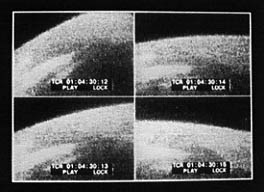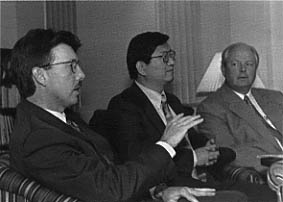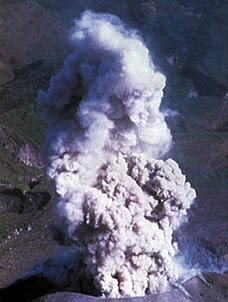![]()
MTU scientists join school kids in rocket launch
MTU signs licensing agreement on fly-ash technology
New process could make wastepaper valuable

The view from there: Images of Wisconsin from space.
MTU scientists join
school kids in rocket launch
The Super-Loki rocket surged spaceward from Sheboygan, Wisconsin, not with a roar but with a whoosh.
"It was different from the majestic launches of the space shuttle," understated Associate Professor Bryan Suits (physics). "It sounded like an extremely loud CO2 fire extinguisher."
The rocket launch came to be through the Aerospace State Association's Rockets for Schools program. Rockets for Schools links university faculty, researchers, and sixth- through twelfth graders in projects that fire up youthful enthusiasm for science. Physics department chair Bruce Rafert is Michigan's representative to the association; his participation provided the foundation for MTU's involvement in the Wisconsin Rockets for Schools effort. In addition to Suits, undergraduate Mike Daniels and graduate student Hank Leckenby worked on the project.
The rocket did more than go very far, very fast. It carried a payload that included sensors to measure temperature and altitude, batteries, a TV camera, and a microcontroller to send back data, "The normal payload that comes with these rockets is a simple temperature sensor," Suits said. "We thought that with modern electronics, we ought to be able to make a much more-sophisticated payload that would fit in with the theme of the Wisconsin project, space, and the environment."
"The other fun thing about the payload was its size-about the same as the cardboard roller inside a roll of paper towels," said Suits, a HAM radio hobbyist, who spent late evenings building the payload in his basement.
At an altitude of about forty miles above the Earth, approximately two minutes after the launch, the payload was ejected from the rocket. After tweaking a few dials, the ground crew, which included students, started receiving video and realized something wasn't quite right. The video showed the payload was tumbling rapidly, a pretty good sign that its parachute had come loose.
"It almost makes you seasick to watch it," Suits said.
Nevertheless, the images received clearly show the curvature of the Earth and the Wisconsin shoreline. In addition, the temperature sensors sent back reasonable readings from the cold vacuum of space-50 degrees below zero Celsius (about minus 60 Fahrenheit). The altitude readings were less reliable. "They started at the ground and worked up," Suits said. "I think the altimeter chip failed."
The Super-Loki launch drew 12,000 spectators, including several hundred students, who were involved in all phases of the launch. "I've been to a lot of these outreach activities, and this far and away was the best one I've seen involving space science," Rafert said. "It really was a grassroots merger of all kinds of people-researchers, university faculty, high school teachers, and students."
Rafert is coordinating a similar rocket project this spring involving both Michigan and Wisconsin.
"It was really exciting and the kids just loved it," he said. "We're looking forward to next year."

MRT President Hugh Shannonhouse, IMP Director Jim Hwang, and MTU President Curt Tompkins (left to right) make the announcement.
MTU signs
licensing agreement
on fly-ash technology
America's electric-utility smokestacks trap about 50 million tons of fly ash every year, and there hasn't been a whole lot done with it.
Until now.
A licensing agreement between Michigan Tech and Mineral Resource Technologies of Atlanta could make fly ash the latest natural resource of the industrial age, as well as garner the University millions of dollars in royalties over the next several years.
Jim Hwang, director of the Institute of Materials Processing, has spent the last ten years studying fly ash, so named because it flies up chimneys (and is trapped in filters) instead of settling on the bottom (like the aptly named bottom ash). Hwang may be the sooty byproduct's biggest booster, envisioning it as a source of products ranging from activated charcoal to plastics filler.
"It's significant that a company located in Houston and Atlanta has proven one of IMP's premises-that if we're answering the needs of industry, we'll link up with industry," MTU President Curt Tompkins said at the signing ceremony kicking off MTU's technology transfer agreement with MRT.
Together, IMP and MRT plan to build a fly-ash cleaning system as a prototype for a full-scale plant. The plant will be built at one of the myriad coal-fired generating plants east of the Mississippi; about forty to sixty sites are in the running. The system will include Hwang's patented processes, which separate out fly ash's component parts: carbon, iron oxide, and cenophores-a low-density form of silicate.
In addition, MRT will pursue new markets for the cleaned-up ash, primarily as a replacement for cement, as well as filler for opaque plastics such as PVC, for ceramic insulators and liners, and for metal composites.
"It could be in everything from golf balls to satellite dishes," Hwang said.
"The MTU scientists have made an important achievement in advancing and patenting this new carbon recovery technology," said MRT President Hugh Shannonhouse. "MRT is extremely excited to bring this technology to the marketplace because it will allow us to effectively transform coal ash from a waste byproduct that is landfilled into a mineral filler product that can be recycled into concrete and other products, thereby reducing the solid-waste stream and utilizing a valuable natural resource."
The licensing agreement is expected to generate millions in royalties to Michigan Tech, according to Sandy Gayk, director of intellectual properties and trademark licensing, who was instrumental in successfully negotiating the agreement.
"We are extremely pleased to have established a long-term partnership with MRT," she said. "They have the ability to commercialize this and future fly-ash technology, and that is a key element in this agreement."
Hwang believes this technology is the vanguard of a new brand of mining-the processing of industrial byproducts to form new materials.
"In the past, most of our raw materials were basically mined from natural resources," he said. "In doing this, we disturbed the Earth, and we were not looking at total efficiency. This technology will reduce the dependence on mining and will lead to a new generation of materials supplies."
New process could make wastepaper valuable
By News Bureau Manager Jim Lutzke
A new process for separating secondary fibers from wastepaper could enable industry to produce valuable commercial products from used paper and cardboard containers that are currently consigned to the trash pile.
Associate Professor Bernard Sun and Research Scientist/ Engineer Robert Hawke, researchers in the School of Forestry and Wood Products, proved the feasibility of their process while working to separate secondary fibers from wastepaper webs in corrugated cardboard boxes. The method involves immersing paper in a small amount of water to weaken the paper's interfiber hydrogen bonds, then using an atmospheric pressure single-rotation disc refiner to convert the paper into pulp. The subsequent separation and drying operations convert the pulp into separate dry fibers suitable for making fiber composites with a dry-consolidation process.
"Our intent was to liberate secondary fibers from paper webs while still retaining most fiber integrity," said Sun. "This process practically frees the wastepaper recycling operation from relying on the availability of a large quantity of water. This would eliminate the water-related pollution and pollution-abatement operations that characterize the hydropulping operations of the 'wet-liberation' process widely used today by the pulp and paper industry."
Sun said that tests conducted at Michigan Tech showed that composite materials produced with the MTU "moist-liberation" process had comparable strength and water-related properties to those produced by the traditional wet-liberation process. The moist-liberation process, however, was less costly.
Sun said the perceived process and equipment simplicity, along with lower equipment and production costs and the ability to manipulate composite product properties and diversity, could enable small-scale investment operations to convert wastepaper into dry fibers for producing various value-added fiber and hybrid composite products.
"The benefits to technology development of a dry-consolidation process for recycling wastepaper could be excellent," he said. "For example, the freedom to locate recycling operations away from rivers, streams, or other major water sources, and near populated regions where wastepaper is concentrated, is an important economic advantage. In addition, the moist-liberation process also offers a better opportunity to retain additives, binders, and property modifiers to manipulate product property and diversity. Many new products characterized by more-durable, water-resistant properties can be made from the fiber composites produced from wastepaper."
Furthermore, according to Sun, plant capital investment and operational costs of the moist-liberation process are reasoned to be lower than those of the wet-liberation process. The moist-liberation process may also benefit the development of new dry-consolidation process technologies for making wood fiber, and wood and non-wood hybrid composites. The potential to establish small-scale, moist-liberation process wastepaper recycling operations in rural and small communities, far from present major paper recycling mills, could be another advantage, he said.
 Living
under the Volcano
Living
under the Volcano
"We are certain that volcanic disasters of previously inconceivable magnitude will occur in the next century," says Bill Rose, chair of the Department of Geological Engineering and Sciences
He should know.
He and his research team, Assistant Professor Ciro Sandoval (humanities), the cultural communications expert, and graduate students Carlos Pullinger and Darrell Sofield, returned from El Salvador, one of many volcano-plagued countries that have added to Rose's frequent flyer mileage.
El Salvador is a densely populated country located wholly within the active volcanic belt of Central America. It has twenty-two volcanoes, with seven being active during historic time. Most of the people live very near or on a volcano where there is an ever-present risk of eruption. El Salvador's rich archaeological history is interspersed with deposits recording volcanic events that are orders of magnitude far more energetic than those in recorded history. This does not bode well for local residents.
Little local infrastructure is devoted to natural hazard mitigation. But since the end of the recent war, interest is growing. El Salvadorans need to know how to predict eruptions, how to be better prepared, and how to lessen the devastation of the aftermath. In addition, they need help in adjusting land-use patterns so that populations are not concentrated in areas where catastrophes are likely.
Significant progress has been made as a result of the last two trips. "We identified local collaborators and initiated two field projects with local scientists and university students," Rose said. "These are centered around our two MS students, Pullinger and Sofield."
An NSF grant will fund the travel for a three-year series of field visits, short courses, workshops, and field trips in El Salvador. The work involves field mapping and a variety of risk communications efforts to improve the people's awareness of volcanic hazards. "We have to explain to people who have lived all their lives on an active volcano that it might actually blow up," says Rose. "That part is easy! The real challenge lies in making them believe us. We have to prove that we are a credible source of information."
The data must be translated into human terms. It is then crucial to ascertain that the knowledge reaches the right people who have the power and resources to act. Rose maintains that intercultural communication is a key element of this technology transfer.
"Because part of our effort involves teaching and communications, there are opportunities for a variety of people, for example, economists, cultural geographers, as well as communications experts, to become involved," he said.
![]()